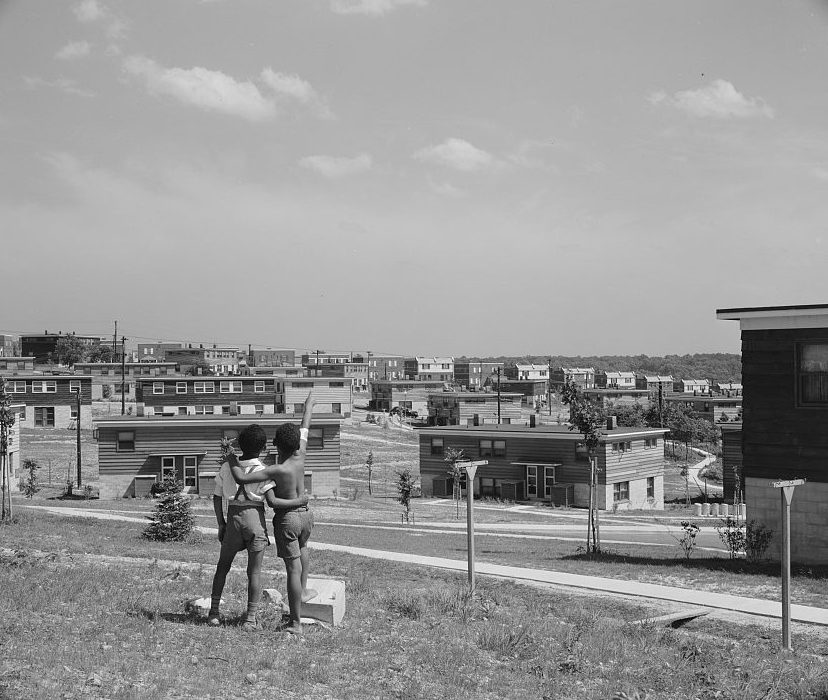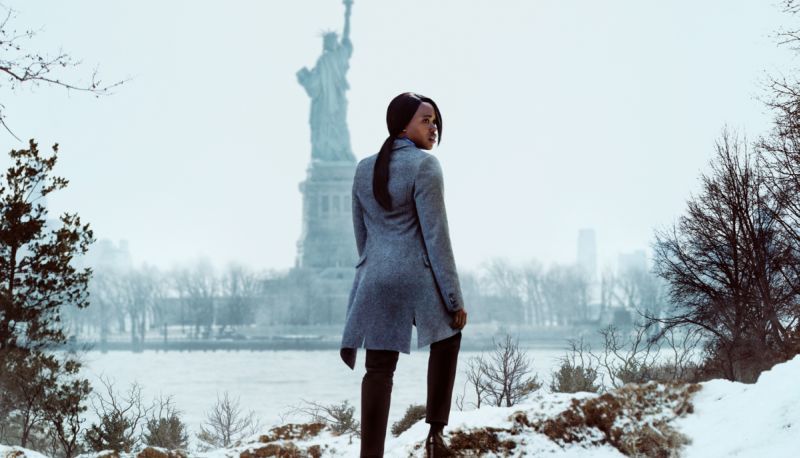On Borders and the Matters of Black Life: A Review of “Seven Seconds”
*Editor’s Note: This essay contains spoilers*
In the recently released Netflix drama, Seven Seconds, viewers are confronted with a dramatization of the harsh and disturbing realities of violent and racialized policing in the contemporary United States. Following a hit and run accident that kills a Black teenager named Brenton Butler, his parents and community seek answers about the callousness shown by whoever left him in a ditch bleeding in the snow for twelve agonizing hours. Eventually, Latrice Butler, played breathtakingly by Regina King, as well as the troubled state prosecutor, KJ Harper (Clare-Hope Ashitey) come to recognize that a group of narcotics cops are responsible for Brenton’s death and the cover-up.
In addition to the struggles of the Butlers in dealing with their loss, the ten episodes of season one garner viewers access to the world of the policemen. Despite their rough exteriors we come to learn that the cops are enacting their own “daddy issues” through the violent and often illicit activities in which they are engaged in in Jersey City, New Jersey’s Black Southside. They garner their sense of invincibility from their power to lord over Black people. The policemen’s families are also portrayed. Marie Jablonski (Michelle Veintemilla), who gives birth shortly after the hit and run, comes to learn of her husband’s role as the driver. Rather than pressing her husband to turn himself in, she convinces him to maintain secrecy. She pressures him to lie in order to ensure her own well-being as well as that of her newborn son. Throughout the season it becomes clear that the white women not only know about the violence and violation that their husbands commit against Black people; they support it insofar as it buttresses their economic security, familial integrity, and social life.
While Seven Seconds is a drama about contemporary issues of police violence, it draws out a fundamental theme of U.S. history: white vitality and futurity have, since the era of slavery, depended on the unmaking and violation of Black life.
In order to further substantiate this claim, let’s return to an era where these relations were explicit. More than simply a backward scheme of parochial violence and control, the architects of Jim Crow articulated a modern system of economic and social value extraction. Elites and working-class whites alike engaged in the compulsory regulation and strategic management of Black life in order to ensure real and imagined wages and property wedded to the social-legal-cultural designation of whiteness. Jim Crow was a regime of civic, social, and moral obligations whereby what it meant to be a good citizen was fixed through the work of regulating the mobility and governing the stillness of Black bodies.
This dynamic is captured in visual culture produced in that era. In 1956, famous Black photographer Gordon Parks set out on assignment with Life to depict the dynamics of the South’s economic and social system and to capture the lives of an extended Black family living in segregated Alabama. Moving between Atlanta, Georgia, and Birmingham, Mobile, and Shady Grove, Alabama, Parks captured variously scaled borders as the fundamental infrastructures of the system. Rather than static points of separation between disparate groups or locations, borders as Parks photographed them served as dynamic meeting points wherein white power was defined, enacted, and embodied through proximity to rather than distance from Black life. Thus, beyond what is often regarded as an arcane and unproductive geography of racially bifurcated space, Jim Crow functioned as a managed system of disparate places wherein social and economic value was generated in the constant recalibration of borders. Through a kind of quotidian border work, white communities helped regulate the spatial matters of Black life and colonize it in the service of their own vitality and futurity.
In one of the 1956 images shot in Atlanta’s airport, Airline Terminal, Atlanta, Georgia, Parks crystallized this dynamic on film. He shot a Black domestic worker holding and comforting a blonde child while its mother anticipates the action of boarding the plane. Here, Parks mapped the place of Black women’s labor within intimate settings in public and private venues. Because he photographed no other Black subjects within the frame, Parks underlined the fact that the formal regulation of contact between populations ensured the regulation and exploitation of gendered Black labor. As Sarah Haley points out, Black women were excluded from a vision of womanhood by the jurists who built the system and within the quotidian social practices of everyday white supremacy under segregation. From the outset of the twentieth century, white domestic interiors, chain gangs, jails, prisons, and prison farms formed a continuum of carceral spaces wherein Black women’s experiences with surveillance and violation in the service of white vitality was enacted through the constant negotiation and fixing of borders.
The white woman for whose child the Black domestic cares embodies novel forms of gender-specific power generated through her authority to strategically control the Black domestic worker. The unnamed white woman’s face and body are in sync and she is clearly positioned to be hailed forward—that is, let on board the aircraft, and also socially confirmed as a modern southern white lady. Her access to flying and the airport symbolize her growing mobility beyond the sphere of the domestic in southern public life due to racial and class privilege. Yet her power contrasts sharply with and is dependent upon the captive mobility of the Black domestic worker. The Black woman was also about to fly when Parks photographed her, yet this is not ultimately of her own volition. Her taught arms contrast with her facial expression, indexing her habituation through threat and violence. She has learned to hold tight to white progeny in order to avoid physical or economic violation. Her ability to fly is conceivable only insofar as her labor insures white futurity. Parks’ image highlights the ways that border work under segregation created the conditions for the strategic habituation of Black people as flesh—available, fungible repositories of raw capacity, only registering as life worth living when in the service of white futures.
Parks caught on film the relationship between white domination and the active debilitation of Black life belied by segregationist discourses of purity and separation. Debilitation, following Jasbir Puar, describes a relationship of violation that is distinctive from modes of sovereign violence deployed to kill. Debilitation describes strategic physical maiming, sexual exploitation, forced sustenance on unsustainable diets, purposeful psychological warping, and other disfiguring and misshaping power that composed the everyday operations of the Jim Crow system. The object of debilitating power under a regime of racial segregation was to ensure the reproduction of stunted, serviceable, and fungible Black flesh, not necessarily to extinguish Black biological existence. The Black domestic worker’s captivity and immobility, in step with the traversal of space by her empowered employer, served as the primary source of gender-specific white domination.
In perhaps the most pointed example of Parks’ efforts to highlight the debilitating effects of borders under formal segregation, Outside Looking In, Mobile, Alabama, he photographed six small Black children as they peered through a chain-link fence to an amusement park that they clearly were not permitted to attend. This image contrasts sharply with an earlier 1942 image Parks shot titled Anacostia, D.C. Frederick Douglass housing project. Boys overlooking the project. In the 1942 image, Parks photographed two young Black boys looking out in anticipation of the promises of a new public housing project. In contrast, the implications from the 1956 image are one of a stifled future horizon. Parks orchestrated and framed this photo to convey the debilitating effects of segregation. He implied that it stunted Black children who were literally fenced out of the normative spaces of American education, leisure, and consumption.

Another image from the 1956 series drives this point home. In Ondria Tanner and Her Grandmother Window-Shopping, Mobile, Alabama, Parks captured a grandmother and granddaughter peering through a department store window at well-dressed white mannequins. Here the glass symbolizes the striated borders whose continual negotiation made the Jim Crow system generative for its powerholders. The implication is that Black southerners should and could see what they could never actually partake in, reifying whiteness and white spaces as that which was valued if unattainable.
At the same time, Parks also captured the possibilities of Black modes of living in a kind of fullness beyond the purview of segregationists and this will help us to identify another key if muted thread within Seven Seconds and our wider contemporary moment. In Airline Terminal Gordon illustrated the dissonance between the Black domestic’s expression and the habituated stance of her body. As I described, her arms are taught with the grip of the white child, a practice likely inscribed in her muscle memory through force. Her face, however, registers quiet wherein, following Kevin Quashie, quiet is understood as a mode of contemplative interiority often generative of but not coterminous with modes of politicized outward expression. The Black domestic laborer’s passing thoughts are obviously unrecoverable and yet in this embodied schism between the quiet multi-verse of the fugitive mind and the fungibility and captivity of the flesh is the very possibility for Black world-making. Precisely at the site of ongoing border work, Parks captures the quiet vitality of Black possibility directly in the face of the deadly infrastructures of segregation.
In spaces where nothing was supposed to live, let alone blossom, except in the service of white vitality and futurity, Black communities created insurgent forms of living. Airline Terminal depicts an internally generated vivaciousness and criticalness that was the affective and emotive infrastructure undergirding Black vitality. In another untitled image Parks took in Mobile, Alabama, two women share a conversation while one of them stands outside the other’s open window. Although their conversation is unrecoverable, the gesture of the hand on her hip suggests that the woman outside has something juicy to tell her friend. They share in and help create a geography of communion where untamed and unrecoverable Black discourse fueled a world in the shadows of white civil society. In another untitled image taken in Shady Grove, Alabama, Parks centered the frame on a woman who glares back toward him while holding a child and surrounded by a number of other fashionably dressed Black people. In photographing the fullness and abundance of congregation, Parks depicted Black vitality as a counter-claim on borders: Borders also created spaces of Black possibility outside the line-view of the pulverizing violence and slow death meant to generate white life through Black unmaking.
Although Seven Seconds is about contemporary policing issues, it also drives forward the possibilities within Black congregation within ghettoized Black spaces. The Butler’s church, and the organized protestors, as well as more illicit forms of communing like the street gang form the substrate out of which transgressive possibility for Black living otherwise is formed. If this country’s dominant group continues to flourish in direct relationship to the grinding down of Black life enacted through borders, recognized and insurgent forms of Black communing continue to fuel alternative visions for the future articulated from the other side.
Copyright © AAIHS. May not be reprinted without permission.

Excellent …
Thanks for the engagement
Really enjoyed reading this, throughly engaging piece.